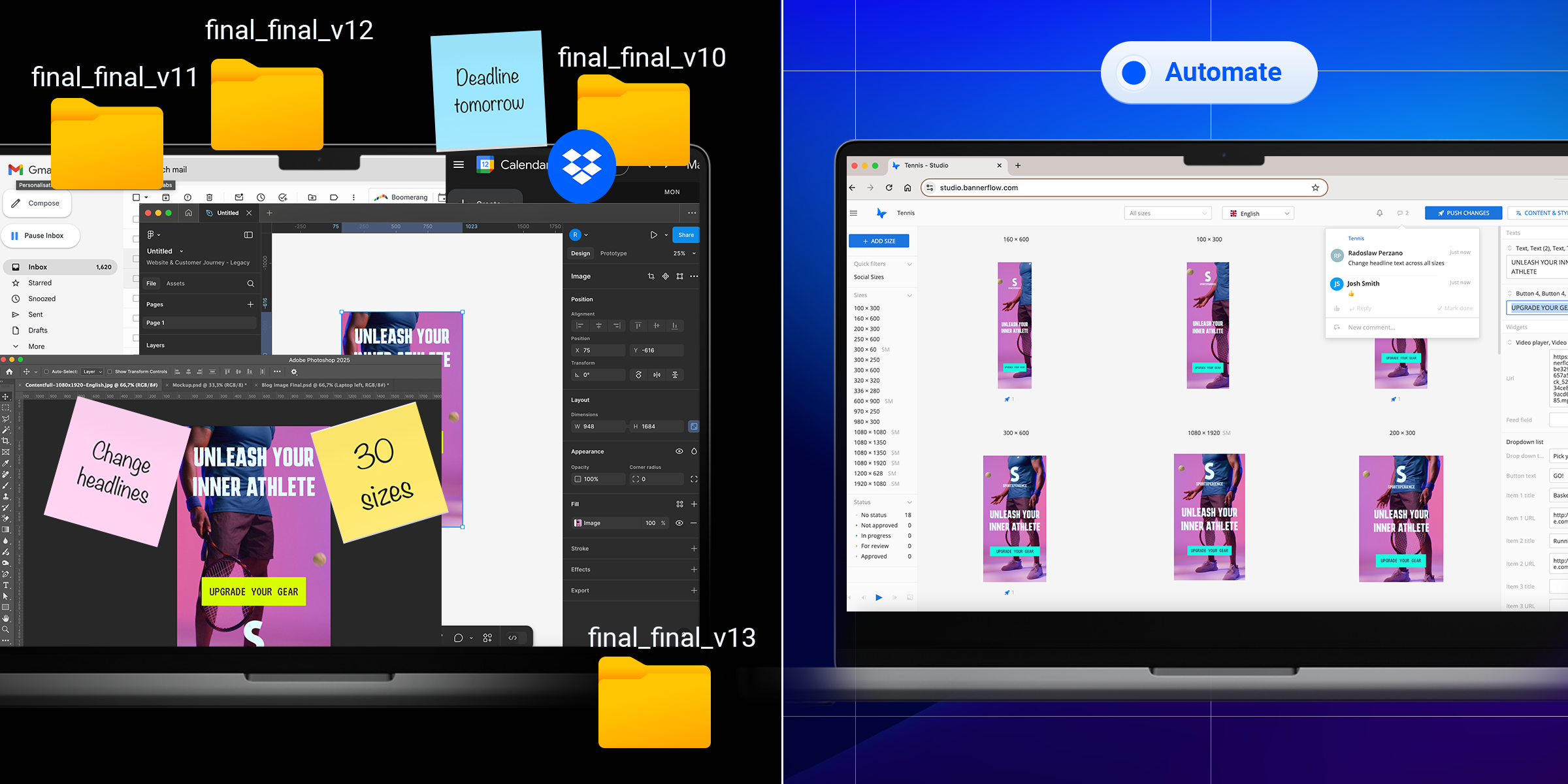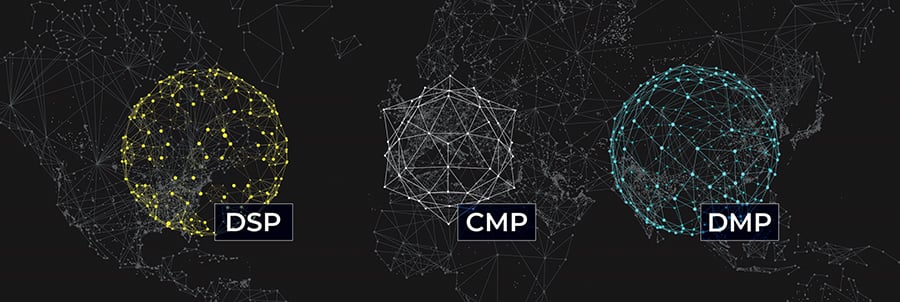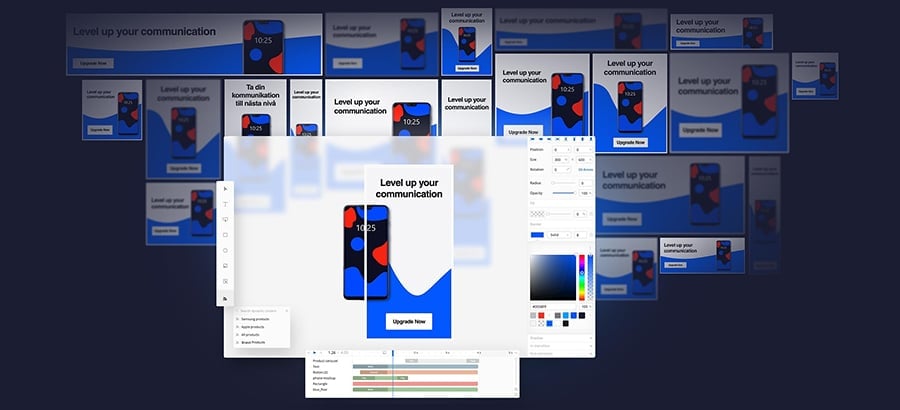Today’s marketing campaigns get harder by the minute. Your budget is tight, your ROI is in danger, and your KPIs have been set higher than ever. And with more communication channels for your customers than ever before, one might expect marketing campaigns to reach their targets easier. But that’s far from the case: audiences demand personalized efforts and each audience segment has different format preferences on content and means of communication. To add fuel to the fire, marketers have a cookieless future ahead of them to plan for.
But the future isn’t all bleak. This is where a popular term comes in: creative automation. More than just a buzzword or a trend, marketing automation platforms help you lighten the load, cutting down production time and freeing up your team to focus on your campaign goals. So, let’s see what creative automation is and how it can help you.
What is creative automation?
In its core, creative automation refers to tools you can use to produce more creatives for your ad campaigns a lot faster. Marketing teams take advantage of creative automation tools to automate repetitive, time-consuming tasks around content production and design. In a time when your teams need to create multiple different visual variations and content messages for each single asset of a marketing campaign, creative automation tools are your designer’s best friend. The same goes for your content team, and everyone involved in the creative process.
Even though its name includes two concepts a lot of professionals are wary of seeing combined, the purpose of creative automation is not to automate the concept of creativity. On the contrary, what it does is take away the hassle of repetitive production tasks, leaving space for more creative thinking and strategy implementation. Automation tools can create multiple variations of a visual adjusted to different dimensions and formats, or produce different variations of a piece of copy - even translating in multiple languages almost instantly. What it is not there for is the actual creative part. That is still left to the best: your creative team.
Creative automation: what it does and what it doesn’t do
You now have a better understanding of what creative automation is. It’s time to get into the specifics: what is creative automation good for, and what is it not going to solve for your marketing teams? Here is a comprehensive table that includes all the things creative automation can do for you - and what it won’t be able to help you with..png?width=1324&height=2112&name=In-Blog-img%20(2).png)
From this comparison, it’s clear that creative automation tools have been designed to cut the production time and help with repetitive marketing tasks that don’t require a lot of participation from your team. Scaling ad creatives, resizing visuals, translation of large amounts of copy, are all work tasks that marketing teams benefit from having automated.
Creative automation tools can also help safeguard your branding strategy, by adhering to branding guidelines and creating templates that make it easier for your teams to keep branding in their mind when creating campaigns.
Creative automation is a great asset for your personalization efforts, too. Personalization demands a lot of different creative iterations of the same ad, based on different audience segments. And the same goes for the messaging. Without creative automation, you would have two options: spend an enormous part of your marketing budget on resources to create all those iterations, or decide to skip on personalization strategies - which would lead to your brand missing a significant part of potential customers.
But creative automation solves this dilemma. By creating a large amount of creative iterations in a significantly small amount of time, creative automation tools make Dynamic Creative Optimization (DCO) possible. Copy is also adjusted faster, and translations can be done in no time.
Now, what can creative automation not do? As you have probably realized by now, creative automation tools don’t have the ability to replace the human factor of your marketing strategy. Creative automation tools can be fed data to rapidly create what they are told to, but they have no creativity abilities of their own. They also don’t hold the experience of a designer or a copywriter - essentially, they work as any other tool.
Creative automation also lacks the ability to make strategic decisions. Since creative automation tools can only understand the data they are fed, they lack the ability to understand nuances, context, or the bigger picture that your marketing team already knows. Campaign strategy is always a human factor, and that won’t change when you introduce a creative automation tool to your team.
What is a creative automation platform, and when do you need it?
Knowing what creative automation can do for your teams is a great start, but how do you know when it’s time to look into a creative automation platform?
For starters, a creative automation platform is the tool that enables marketing teams to produce, manage, and scale their creatives faster and in greater numbers. Their features might vary, but the main features of most creative automation platforms are:
- Smart Templates
- Dynamic Content Creation
- Multi-Channel Output
- Real-Time Update Enablement
- Collaborative Tools
So, when do you know that it’s time to adopt a creative automation platform in your marketing team? If you’re wondering whether you’ve reached the point when you need it, here are some clear indications that it is time to start looking into them.
It takes too long to deploy your campaigns
You know that marketing campaigns can be very time-sensitive. Imagine having to deploy a campaign in 5 different markets, with the creatives needing 10 different sizes and 4 different formats. That’s 200 creatives right there. Add copy translations for each market, and the workload is now adding up for both designers and content creators. How fast (and how often) can your team deploy a campaign like that?
If you find your team struggling often to keep up with the campaign timelines, it might be the production workload that’s creating the issue. Creative automation tools can help your teams automate some of the time-consuming production tasks and help you deploy your campaigns on time.
You’re looking into personalization at scale
As mentioned before, personalization can help your marketing campaigns soar - but it needs a lot of resources. You deploy different ads based on your segmentation. This means a lot more produced creatives, and a multitude of copy iterations. Personalization at scale also demands you to react fast, adjusting to how your audience perceives your campaigns and reacts to your ads.
This is where creative automation comes in. A creative automation platform helps you produce the ads you need fast, both regarding design and copy-wise. You can translate in different languages in next to no time, and adjust your campaigns fast. With creative automation, production becomes fast, workload becomes manageable, and your team will be able to keep up with the demands of personalization at scale.
Creative production takes too much time
You might have reached the point where marketing production feels like a grind to your team. A lot of requests coming in, and not enough time to do it all? Maybe all the small tasks add up to create a big pile of unmanageable work? A frequent sign that you need to incorporate a creative automation platform into your workflow is marketing teams communicating that they don’t have enough time for the important, strategic aspects of campaigns. Instead, they could be drowning in repetitive tasks that could easily be automated.
Creative automation can take that burden off your team’s shoulders. This is exactly what creative automation tools were built for: automating repetitive tasks. A creative automation platform will free your creatives to do what they do best, while giving everyone peace of mind by ensuring the production tasks are taken care of.
You’re looking into repurposing (a lot of) older material
Reusing material in your campaigns is a smart way to reduce production time, especially when that material has proved successful in the past. But even repurposing can be time-consuming. Creative automation tools help you make the adjustments you need and create more iterations of an ad faster. Creative automation will also help you keep branding consistent across all your material. This is even more important if the material is old, but it’s useful in all cases. Marketing teams often struggle with brand consistency, and a creative automation tool can safeguard your brand easily and without any significant effort from your marketing teams.
Creative automation is a marketer’s best friend
Creative automation is incredibly valuable to marketing teams. Used right, it can cut out the time of tedious, repetitive tasks, help you adjust both visuals and copy fast, and free your teams to do their best creative and strategic work. If you are constantly feeling burdened by the workload and your team can’t keep up with the strategy’s demands, it’s time to look into adopting a creative automation platform.
If you want to learn more about creative automation, you’re in the right place. You can look more into how a creative automation platform can help you reach your goals here.








